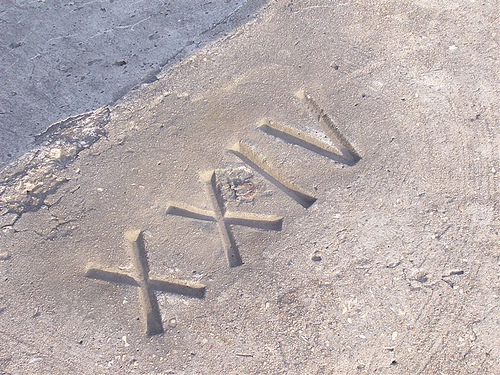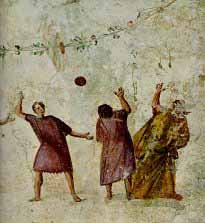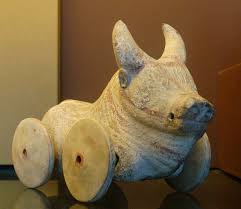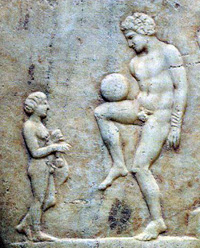Roman Activities for Kids, As soon as a child was born, it was kept before its father’s feet. If he raised the child in his arms, he was acknowledged as his own and admitting it to all rights and privileges of membership in a Roman family.
If he did not take it out, the child was an outcast, without family or protection. If a child was to be disposed of, it was exposed; that is, taken from the house by a slave and left by the roadside. This, however, did not often occur.

Dies Lustricus
During the first eight days of a baby’s life, there were various religious ceremonies. The day of naming was usually called ‘dies Lustricus’ or ‘the day of purification’ for the ceremony performed that day is a Roman Activities. On this day, the family rejoiced.
Games fo Roman Kids
A child’s first toys were the tiny ones of the compendia. Then came rag dolls and dolls of clay or wax, some with jointed arms and legs. There were also ivory letters like our letter blocks, carts for mice, tops, hoops driven with sticks, stilts, and balls.
Outdoor Activities
There were various indoor as well as outdoor Roman activities which children learned like for instance, there has been a reference made to games like blindman’s buff, hide-and-seek, seesaw, and jackstones. Games were played on boards, and pebbles and nuts were used as children today use marbles.

Training of Children
The training of children was conducted by their parents, with emphasis on moral rather than intellectual development. The most important virtues for a child to acquire were reverence for the gods, respect for the law, unquestioning and instant obedience to authority, truthfulness, and self-reliance.
Until the age of seven, boys and girls were taught by their mother to speak Latin correctly and do elementary reading, writing, and arithmetic. At seven a boy went on to a regular teacher and a girl remained her mother’s constant companion. A girl’s formal education was cut short because a girl married early and there was much to learn about home management. From her mother, a girl learned to spin, weave and sew.
Training of Boys
A boy, on the other hand, was trained by his father. If his father was a farmer, he learned to plow plant and reap. If the father was a man of high position in Rome, his son stood beside him in the atrium when callers were received, so as to gain some practical knowledge of politics and affairs of state. The father trained the son in the use of weapons in military exercises, as well as in riding, swimming, wrestling, and boxing.
However, no special ceremony marked a girl’s passing into womanhood, but when a boy reached his majority; he discarded the crimson-bordered toga of a child and donned the pure white toga of a man. The year of the boy’s coming of age varied, somewhat on his physical and intellectual development, somewhat on his father’s decision, more perhaps on the time in which he lived.
In general, a man’s toga was assumed between the fourteenth and seventeenth years – the later age being customary in earlier times. In the classical period, the boy’s age was usually about sixteen. After that, a boy was placed by his father in the care of some man who was prominent in the army or in civil life, with whom the youth spent a year in training.
School life of Roman kids
In ancient Rome, only children from wealthy families went to school since the schools were not free. Poor families needed their children to help work. Poor families could not pay the tuition. Often children from poor families were taught by their parents at home.
Some Roman families paid schoolmasters to teach their children. Schools were usually just one room. There were about twelve students in a class. Often the teachers were Greek slaves. The Romans thought the Greeks were smart.
Children used wax tablets. They would scratch words or numbers in the wax with a pointed stick. Roman books were on rolls of paper called scrolls. Each end of the paper was attached to a rod. The reader had to unroll each page to read the book. People used small reeds to write on the scrolls. The ink was made from a kind of tar called a pitch or from an octopus.

School lasted until the children were about age 11. A few boys would continue to go to school, but girls went home to learn how to run a home. The boys of the wealthy class continued school. They attended a “grammar” school. There they learned different Roman activities and Latin, Greek, grammar, and literature. At age 16 some boys continued their education. They attended classes to prepare as a public speaker. Children of very wealthy families were taught at home by tutors.
Toys
In Ancient Greece and Ancient Rome, children played with dolls made of wax or terracotta, sticks, bows and arrows, and yo-yos. When Greek children, especially girls, came of age it was customary for them to sacrifice the toys of their childhood to the gods. On the eve of their wedding, young girls around fourteen would offer their dolls in a temple as a rite of passage into adulthood.

As technology changed and civilization progressed, toys also changed. Whereas ancient toys were made from materials found in nature like stone, wood, and grass modern toys are often made of plastic, cloth, and synthetic materials. Ancient toys were often made by the parents and family of the children who used them, or by the children themselves. Modern toys, in contrast, are often mass-produced and sold in stores.
This change in the nature of toys was exemplified by the changes that have taken place in one of the oldest and most universal of human toys; dolls. The earliest and most primitive dolls were simple wooden carvings and bundles of grass. Egyptian dolls were sometimes jointed so that their limbs could move realistically.
Material of Toys
By the early 19th century there were dolls that could say “mama”. Today there are computerized dolls that can recognize and identify objects, the voice of their owner, and choose among hundreds of pre-programmed phrases with which to respond. The materials that toys are made from have changed, what toys can do has changed, but the fact that children play with toys has not changed.
Different kinds of Roman Activities
The ancient Roman people engaged themselves in different kinds of Roman Activities some of which are played by people till today. The most important exceptions are card games, which were not invented until the late middle ages, and chess, which did not come to Europe from India until the Islamic Empire, about 1000 AD.
The most common games were probably dice games, where you threw the dice and bet on the results. These were essentially gambling games. But the Romans also played marbles and knucklebones. Knucklebones were like the present day jacks. One threw up one of the knucklebones and tried to scoop up some of the other knucklebones and then catch the first one before it hits the ground. The ancient Roman kids could also play with any small stones.
Indoor Games
The Romans also played games like checkers and a lot of games where you moved pebbles from one square to another in a grid. We find these grids scratched into floor stones and floor tiles all over the Roman Empire, in houses, and by guardhouses, and in amphitheaters, wherever men or women, boys or girls, had some time to waste.

The Romans also played more active games. They played ball games, sometimes with a small ball and sometimes with a big heavy ball that was more exercise.
At the end of the school day, children loved to play games. Roman children participated in various games or Roman activities like rattles, scooters, jump rope, yo-yos, seesaws, swings, kites, balls, board games, hobby horses, carts hitched to goats, ponies, or dogs, models of animals and people hoops with pieces of metal on them like bells, stilts, weight lifting etc.
Apart from these there were some games also like: tic-tac-toe, boys played war with wooden swords, leapfrog etc.
More info on- Ancient Roman arts



